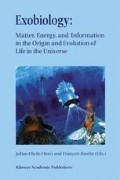Abstract
Seven thermal protein complexes and the dialyzed products from one of these produced typical protocells (0.1–10 µm in diameter) on their surfaces when moistened with water. Protocells (about 0.5 µm in diameter) were visualized (800–1200x): almost instantly at 60 C; within a few min at 23 C; and, after about 15 min at 4 C. Protocells of about 3.0 µm diameter were observed associated with the thermal protein surfaces: within 30 sec to a few min at 60 C; after 4–10 min at 23 C; and, after 9 hr at 4 C. In all cases, the small protocells were free or in loose aggregates. The large protocells were often: free; linked in chains (filaments) or dendritic structures (5–15 protocells in the branched structures); or, more rarely, multi-linked protocellular clusters (15 or more protocells). This method of observing protocell formation provides opportunities for the study of factors involved in the self-assembly process and in protocell survival (e. g., effects of nutritional requirements for growth, differentiation, and reproduction).
Access this chapter
Tax calculation will be finalised at checkout
Purchases are for personal use only
Preview
Unable to display preview. Download preview PDF.
References
Fox, S. W. 1988. The Emergence of Life: Darwinian Evolution from the Inside. Basic Books, New York.
Fox, S. W., P. R. Bahn, A. Pappelis, and B. Yu. 1996. Experimental retracement of terrestrial origin of an excitable cell: Was it predictable? In Chemical Evolution: Physics of the Origin and Evolution of Life, J. Chela-Flores and F. Raulin, Eds., Kluwer Academic Publishers, Dordrecht, pp. 21–32.
Pappelis, A. and S. W. Fox. 1995. Domain Protolife: The Protocell Theory. In Evolutionary Biochemistry and Related Areas of Physicochemical Biology, B. F. Poglazov, B. I. Kurganov, M. S. Kritsky, and K. L. Gladilin, Eds., Bach Institute of Biochemistry and ANKO, Moscow, pp. 151–159.
Pappelis, A. and S. W. Fox. 1995. Domain Protolife: Protocells and metaprotocells within thermal protein matrices. In Chemical Evolution: Structure and Model of the First Cell, C. Ponnamperuma and J. Chela-Flores, Eds., Kluwer Academic Publishers, Dordrecht, pp. 129–132.
Pappelis, A. and S. W. Fox. 1996. Thermal peptides as the initial genetic system. In Chemical Evolution: Physics of the Origin and Evolution of Life, J. Chela-Flores and F. Raulin, Eds., Kluwer Academic Publishers, Dordrecht, pp. 157–165.
Kolesnikov, M. P. 1991. Proteinoid microspheres and the process of prebiological photophosphorylation. Origins of Life and Evolution of the Biosphere 21: 31–37.
Woese, C. R. and G. E. Fox. 1977. The concept of cellular evolution. J. Mol. Evol. 10: 1–6.
Becerra, A., S. Islas, J. I. Leguina, E. Silva, and A. Lazcano. 1997. Polyphyletic gene losses can bias backtracking characterizations of the cenancestor. J. Mol. Evol. 45: 115–117.
Mushegian, A. R. and E. V. Koonin. 1996. A minimal gene set for cellular life derived by comparison of complete bacterial genomes. Proc. Natl. Acad. Sci. USA 93: 10268–10273.
Mushegian, A. R. and E. V. Koonin. 1997. Response. J. Mol. Evol. 45: 117–118.
de Duve, C. 1991. Blueprint for a Cell: The Nature and Origin of Life. Burlington, NC, Neil Patterson Publishing.
Siefert, J. L., K. A. Martin, F. Abdi, W. R. Widger, and G. E. Fox. 1997. Conserved gene clusters in bacterial genomes provide further support for the primacy of RNA. J. Mol. Evol. 45: 467–472.
Ivanov, O. C. and B. Fortsch. 1986. Universal regularities in protein primary structure: preferences in bonding and periodicity. Origins of Life and Evolution of the Biosphere 17: 35–49.
Ivanov, O. C. 1993. Some proteins keep ‘living fossil’ pre-sequences. Origins of Life and Evolution of the Biosphere 23: 115–124.
Author information
Authors and Affiliations
Editor information
Editors and Affiliations
Rights and permissions
Copyright information
© 1998 Springer Science+Business Media Dordrecht
About this paper
Cite this paper
Pappelis, A., Fox, S.W., Grubbs, R., Bozzola, J. (1998). Animate Protocells from Inanimate Thermal Proteins. In: Chela-Flores, J., Raulin, F. (eds) Exobiology: Matter, Energy, and Information in the Origin and Evolution of Life in the Universe. Springer, Dordrecht. https://doi.org/10.1007/978-94-011-5056-9_26
Download citation
DOI: https://doi.org/10.1007/978-94-011-5056-9_26
Publisher Name: Springer, Dordrecht
Print ISBN: 978-94-010-6124-7
Online ISBN: 978-94-011-5056-9
eBook Packages: Springer Book Archive

